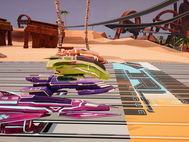
Interstellar Racing League
Maps
Here is an overview of the map that I was directly responsible for. It is set in a desert canyon surrounded by sand dunes and populated with bones of long-dead animals. I designed the track and the base geometry of the map. I started with a paper prototype and after approval by my lead moved into white boxing the track space. After several iterations to ensure the design worked with the vehicle systems, I implemented the gameplay elements of boost and shield and balanced their placement to ensure good gameplay with multiple rounds of internal testing.
Personal Post Mortem
-
I started the project by volunteering my knowledge of peer leadership in stressful scenarios that I learned in the Corps of Cadets at Texas A&M
-
Better planning at the beginning of the project to avoid crunch scenarios
Team Post Mortem
-
Producer holds the team accountable
-
Be honest about the realities of development: some things must come before others, and we should plan accordingly
-
Quicker scheduling, more accurate requests
-
Write code for the bare minimum, not edge cases, then expand
-
Read the game design document
-
Group lunches to boost team morale
-
The game designer needs to be plugged into a team

Game Overview
Interstellar Racing League was designed as a super fast competitive couch racing co-op game simular to Redout and F-zero
My Contributions
-
I designed prototype ideas tracks on paper
-
I built out prototype tracks for playtesting
-
Built out the Canyon track in the final game
-
Placed gameplay elements on all the maps
-
Playtested for quality assurance
My Shipped Map
-
I have tasked with designing a one-lap track for the finale of the game
-
My inspirations were from Star Wars episode 1 pod racing scenes and Martian landscapes
-
I designed the map to empower each of the 4 vehicle types by including areas that they excelled in, such as tight turns or long straightaways
Production Screenshots
Design Process
-
The lead and I sat down and discussed what the game needed map wise.
-
The design of the maps needed to consider the pillars of the game
-
Fast-paced gameplay
-
Antigravity moments along the track
-
-
-
I designed 10 different maps on paper
-
Sections of my paper maps were selected that worked best towards the vision of the game
-
I blocked out those areas using a spline tool and playtested the areas for fun and playability
-
I was greatly concerned with the inverted portions and tight turns of the track as the game emphasized low or no gravity in sections and high speeds
-
-
We met as a team, discussed the play of the blockouts, and decided on what changes would need to be made
-
I made the necessary adjustments for the track at that time
-
Made the corners of the track gentler so the vehicles could smoothly turn
-
Incorporated more shortcuts
-
-
After the track was approved, I blocked out the near scenery for the artists and the environment designers to build out the world but not impact gameplay
-
Upon getting the map back from the environment team, I incorporated the power-ups and speed boost pads to the map
-
This could not be done before the environment team did their work because if the player was going too fast the visuals could block the track ahead and the player would have trouble maintaining a mental map
-
-
The track was then playtested for any inconsistencies and bugs and would get approved by the game designer and track lead
Design Goals
-
Collaborate with every discipline (Production, Programming, Art, and Level Design) to create a couch racing game
Game Engine
-
Unreal Engine 4.17
Development Time
-
4 months (3 hours a week, only weekdays), approximately 240 hours per developer
Genre
-
Racing
This racing game was built by 60 students, broken into teams from 5 to 15 students that tackled various tasks. The teams were track, environment, artificial intelligence, physics, special effects, and general game development. I was on the track design team where we prototyped, designed, and built out the play spaces for the game. This process was implemented through a pipeline which allowed for smooth and rapid iterations on our designs based on feedback from stakeholders and playtesters.









